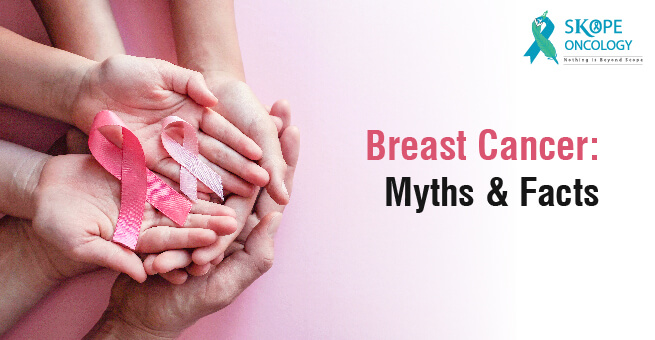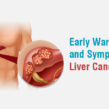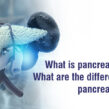Breast cancer develops when cells in your breast multiply and grow out of control, resulting in a mass of tissue known as a tumour. Breast cancer symptoms can include the presence of a lump(s) in the breast, changes in breast size, or changes in the skin around your breasts.
Breast cancer is the most common type of cancer in women, accounting for 14% of all cancers in Indian women. Breast cancer survival rates in India are low because the disease is diagnosed late, and the only way to change this is by raising public awareness.
October is Breast Cancer Awareness Month, a yearly campaign to raise awareness of the effects of breast cancer. On this occasion, let us dispel eight common myths concerning breast cancer.
Myth #1
If you have a lump in your breast, you have breast cancer.
Although a lump in the breast is a common sign of breast cancer, not all lumps are cancerous growths. They may also develop as a result of a cyst (fluid buildup) or a fibroadenoma, a non-cancerous tissue growth.
However, if you discover a new persistent lump in your breast or notice any changes in breast tissue, it should never be ignored. It is critical that you see a physician for a clinical breast exam.
Myth #2
Only women are affected by breast cancer.
Breast cancer is commonly thought to affect only women, but men can develop it in rare cases, and it typically affects men over 60 years of age.
Male breast cancer symptoms include a hard, painless lump in the breast, nipple discharge, a sore or rash around the nipple that does not go away, and small bumps in the armpit.
Myth #3
A mammogram can lead to the spread of breast cancer.
Breast compression during a mammogram cannot cause cancer to spread. A mammogram, on the other hand, is a reliable tool that aids in the diagnosis and early detection of breast cancer.
Mammograms require very small doses of radiation, and the risk of harm from this radiation exposure is extremely low.
It is advised that women aged 40 and older who have one or more risk factors for breast cancer, such as a family history or a genetic mutation (such as in the BRCA gene), undergo annual breast cancer screenings. However, seek the advice of an oncologist and choose what is best for you.
Myth #4
Breast cancer is contagious and spreads through physical contact.
Breast cancer develops as a result of mutated cells growing out of control and spreading to nearby tissues. It is not contagious and you cannot catch breast cancer or transfer it to someone else through mere physical contact.
However, you can lower your risk of developing breast cancer if you have one or more risk factors by seeking medical advice and following the guidelines for breast cancer screening.
Myth #5
If the BRCA1 or BRCA2 gene mutations are found in your DNA, you will undoubtedly develop breast cancer.
Though having mutations in the BRCA1 or BRCA2 genes increases the risk of developing breast cancer, it is not a definitive cause.
Studies have shown that not every woman with a harmful BRCA1 or BRCA2 mutation will develop breast and/or ovarian cancer, but a woman with an inherited harmful BRCA1 or BRCA2 mutation is about five times more likely to get breast cancer than a woman without such a mutation.
There are several proactive steps that can be taken by people who find out they have the harmful mutation to lower their risk, such as hormonal therapy or bilateral prophylactic mastectomy.
Myth #6
Using antiperspirants and deodorants can lead to breast cancer.
Antiperspirants and deodorants contain aluminium-based compounds as active ingredients, which are known to have oestrogen-like hormonal effects that may contribute to the development of breast cancer.
There is, however, no conclusive evidence that aluminium exposure increases the risk of developing breast cancer, and no studies have found any significant adverse effects of aluminium that could help explain this.
Myth #7
Women without a family history of breast cancer are not at risk.
The risk of developing breast cancer is generally lower for women who do not have a family history of the disease. However, the risk cannot be ruled out because the majority of women diagnosed with breast cancer do not have a family history of the disease.
Regardless of family history, it is important to talk with a healthcare provider about recommended mammography screening schedules and schedule regular screenings because age and gender both contribute significantly to the risk of developing breast cancer.
Myth #8
The only treatment option for breast cancer is mastectomy.
Although breast surgery is the most common form of treatment for breast cancer, mastectomy (removal of the entire breast) is not the only option.
Breast conserving surgery, or lumpectomy, is another surgical procedure that may be used to treat early-stage breast cancer that has smaller cancerous tumours. The procedure entails the removal of the cancerous lump and a portion of the surrounding healthy tissue, along with one or more armpit lymph nodes. Although a lumpectomy helps to preserve breast tissue, it is required to be followed-up with radiation therapy to mitigate the risk of a relapse.
The type of surgical procedure, however, is determined by individual patient factors, and the breast surgeon would choose one of the breast surgery options based on whether a lumpectomy with radiation treatment would provide the same prognosis as a mastectomy.
References:
- Breast Cancer Myths https://www.nationalbreastcancer.org/what-is-breast-cancer/
- Breast Cancer Myths https://www.missionrmc.org/services/breast-care-center/breast-cancer-myths/





